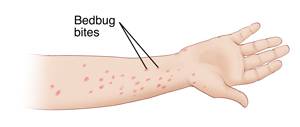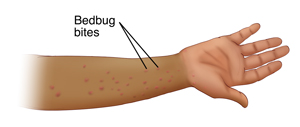Bedbugs
After years of being very rare in the U.S., bedbugs are making a comeback. These bugs are small, about the size of an apple seed. They are reddish-brown, oval, and look slightly flattened. Bedbugs feed on human and animal blood, usually at night. Bedbugs are a nuisance. But they're not a major threat to your health.
Facts about bedbugs
-
Bedbugs are active mainly at night. During the day, they hide in dark places, often in and around where people or animals sleep. They are commonly found on mattresses and box springs and behind headboards. But they can hide anywhere.
-
Bedbugs are small and hard to see. They're often carried from place to place in items like luggage, furniture, and clothing. This is why they spread so easily.
-
Bedbugs aren't attracted to dirt. Even the cleanest house or hotel can have bedbugs.
-
Unlike mosquitoes, bedbugs don't spread disease. If you're bitten, you don't have to worry about catching a blood-borne illness.
-
Insect repellents have little effect on bedbugs.
-
Adult bedbugs can live for several months without a blood feeding.
-
Bedbugs are very hard to get rid of. If an infestation is suspected, it's advised that you call a professional exterminator.
Signs of bedbugs
Bites can be the first sign of a bedbug infestation. When inspecting for the bugs, look in crevices of mattresses and box springs, behind the headboard, and in and on objects near or under the bed. You may see the bugs themselves. Or you may see tiny dark stains on fabric or carpets. Smears of blood on sheets and nightclothes on waking up are another sign. In some cases, the bugs are so well hidden they can’t be found unless items are taken apart.
Bedbug bites
 |
| Bedbug bites on light skin. |
 |
| Bedbug bites on dark skin. |
Bedbugs look for food at night. They bite while people or animals are sleeping. The bites are most often painless. Many people never know they’ve been bitten. But some people develop an itchy red welt or swelling. And if a person has an allergic reaction, severe itching, blisters, or hives can develop. Bites are often on areas that are exposed, such as the head, neck, arms, and hands. Bedbug bites aren't dangerous and don’t spread illness. But if the bite is scratched and the skin is broken and irritated, there's a chance that a skin infection can develop.
Treating bites
Bite symptoms usually go away on their own in 1 or 2 weeks. During this time, over-the-counter (OTC) hydrocortisone ointment or cream can help ease itching and swelling. If itching is more severe , an OTC antihistamine that’s taken by mouth (oral) can help. If an infection develops from scratching the bites, your healthcare provider can prescribe an antibiotic.
If you were bitten by bedbugs in your home, talk to a licensed pest-control professional or company. They can inspect your home and help you get rid of the bugs safely.
When to call your healthcare provider
If you have bites, call your healthcare provider right away if you develop any of the following:
-
A fever of 100.4°F ( 38°C ) or higher, or as advised by your provider
-
Signs that the bites are infected, such as increased swelling and pain, warmth, or oozing
-
Signs of allergic reaction, such as hives, spreading rash, throat itching or swelling, or wheezing
Preventing bedbugs
-
Don't buy used beds. If you do buy used bed frames, mattresses, box springs, or other furniture, check them carefully for bedbugs before bringing them into your home.
-
If bedbugs are found or believed to be in the bed, use mattress and box spring encasement covers that can seal in bedbugs so they'll die there.
-
When traveling, remove linens from the top of the bed and check the mattress and headboard for signs of the bugs. Place luggage on a hard surface, such as a table or on a luggage rack. Don't place luggage on the floor.
-
If you think you were exposed to bedbugs while traveling, wash all clothing in hot water as soon as you get home. Washing alone will not kill the bugs. Clothing must be put in a dryer at high temperatures, at least 113°F (45°C) for 1 hour.
-
Never pick up items discarded on the street for use in your home. These include bed frames, mattresses, box springs, or upholstered furniture. These items may carry bedbugs.